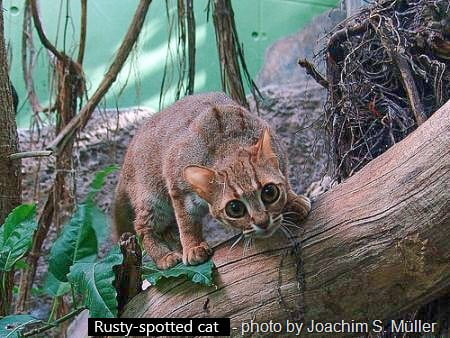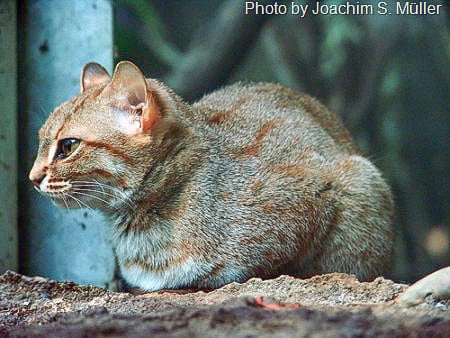Introduction – overview – summary: The rusty-spotted cat is the world’s smallest feline, domestic or wild. They look somewhat like a domestic cat and there is an interest in adopting one as a companion but please don’t (please click this link to read about). It has been described as the “hummingbird of the cat family” which is an apt description because it is about half the size of a domestic cat, extremely agile and active. The “rusty” reference in the name comes from the grey fur tinged with a rufous colour. The distribution appears to have expanded north over recent years according to the Red List as at one time they were confined to Sri Lanka and mid-southern area of India. They like to live in moist and dry deciduous forest, tropical thorn forest and scrub forest and also grasslands or scrubland. You will also see them on rocky areas and hill slopes.
Often you see them in “teak, bamboo, grassy areas and dry thorny vegetation” according to Wild Cats of the World. They mainly eat small mammals, birds, lizards, frogs and insects. They are known to kill the occasional domestic chicken and ducks when the opportunity arises and have a tremendous appetite. In captivity a rusty spotted-cat weighing 5 pounds ate 4-6 ounces of meat mixture and a dead mouse or chick every day according to P. Callaghan in 1991 in his document ‘Cat Tales: Newsletter of the International Society of Endangered Cats’.
RELATED: Rusty-spotted cat size compared to domestic cat size

RELATED: Great picture of a rusty-spotted cat and 13 facts
Conservation is the most pressing of issues for all the wild cats. In 2002 the Cat Survival Trust website, which was last updated in June 2002, says that this cat was not considered to be threatened by the IUCN Red List of Threatened Species™ (Red List). This would make the classification at that time, NT (Not Threatened). Today, at June 2009, the Red List classifies this wild cat as Vulnerable (VU). This is one more stage towards extinction. I discuss this further below. Update: as at May 15, 2022, the conservation status is described as Near Threatened. So, the position is stable, according to experts.


RELATED: What does the rusty-spotted cat eat?



Comments are closed.